RELG 402 - World's Living Religions
Navajo Religion
When discussing any religion there are sensitive areas which may not be understood by those who are not members of the religion. This is particularly true of Native American Religions, where some topics may be secret, and are not meant to be open to secular view. To the best of my knowledge, the following information has been made freely available by members of the religion involved, and is published here in the interests of mutual understanding and respect. If the information below is incorrect, or if its publication may be offensive to members of the religion, please
contact me
Much of the information below comes from
Hastiin Tlo'tsi Hee, The Age of Beginning, transcribed in 1928 and published in O'Bryan, Aileen (1956), The Diné: Origin Myths of the Navajo Indians. Smithsonian Institution Bureau of American Ethnology, Bulletin 163
Ethelou Yazzie, Navajo History, Rough Rock Press, Rough Rock AZ (1982)
Paul G. Zolbrod, Diné bahané: The Navajo Creation Story, Albuquerque: University of New Mexico Press (1984)
| History | Creation | Ye'is | Hózhó | Ways | Singers |
| Sand Paintings | Medicine Bundle | The Sweat Bath | Sacred Colors | Family and Clans | Death |
Images in the text are linked to larger photos - click on them to see the larger pictures.
Hover the mouse over the images to see their captions.
![]()
The Navajo live in the Four Corners area of the USA - where the states of New Mexico, Arizona, Colorado, and Utah meet. The traditional Navajo lands are bounded by their four sacred mountains and two sacred rivers :
North : Dibe'ntsaaa or Mt. Hesperus, west of Durango, in Colorado
South : Tsoodzil or Mt. Taylor, near Grants, New Mexico
East : Tsisnaajini' or Mt. Blanca, east of Alamosa, Colorado
West : Doko'oosliid or the San Francisco Peaks, above Flagstaff, Arizona
The two rivers form the north and south borders of the region :
North : the San Juan River, along the southern border of Utah
South : the Little Colorado River, through Arizona
The Navajo came to their lands, probably in the 1500s, as part of the migration of Athapaskan peoples from the north, and settled into the lands of the Pueblo peoples and the Hopi. The Navajos' name for themselves is the Diné (the People), and the name of their land Dinétah
When Spain colonized New Mexico, there were some serious clashes of culture, which led to wide-spread revolts of Native American peoples against the Spanish overlords. The main revolt was led by Popé, a member of Tewa Pueblo, who called for a general rebellion of all the pueblos against the harsh rule of the Spaniards. During the period 1680-1696 many of the Pueblo peoples fled to Navajo and Hopi regions, where they stayed, intermarried, and exchanged cultural and religious ideas. For example, the Hopi and Pueblo "Kachinas" became the Navajo "Ye'i", and the Navajo adopted Sand Painting and weaving.
New Mexico passed from Spanish rule to Mexican in 1821, but in 1846 the United States attacked Mexico and gained control of Arizona, Nevada, California, and parts of Colorado, Utah, and New Mexico (which at that time was much larger than the present state). In 1863 the U.S. government ordered that the Navajo be moved to Fort Sumner - they resisted, and a policy of starvation was enforced throughout the winter of 1863-1864 - their crops and trees were burned, their wells were poisoned, their animals were killed, until in March 1864 the Long Walk of 300 miles to Bosque Redondo by Fort Sumner was enforced. Thousands of Navajo died on the Long Walk, and more thousands died in captivity at Bosque Redondo.
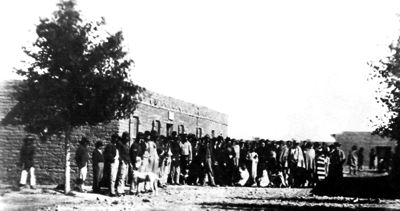 In 1868 the U.S. government decided to relocate the Navajo to a small part of their original lands, in the Four Corners area, which at that time the government deemed to be worthless (they did not know about the mineral deposits - including uranium - which have been discovered since then). The government expected that the Navajo would soon die out from starvation and the rigors of life on their reservation. However, the Navajo did survive, and learned to live off their land - they are now the largest remaining Native American people.
In 1868 the U.S. government decided to relocate the Navajo to a small part of their original lands, in the Four Corners area, which at that time the government deemed to be worthless (they did not know about the mineral deposits - including uranium - which have been discovered since then). The government expected that the Navajo would soon die out from starvation and the rigors of life on their reservation. However, the Navajo did survive, and learned to live off their land - they are now the largest remaining Native American people.
![]()
Diné Bahane, the "Story of the People" is the Navajo account of Creation. It is a series of sacred stories which are told to the children, and which are commemorated throughout the year. There is no set written account - no canon of scripture - and there are variations of the stories as told by different families and in different villages.
The account starts with the creation of Holy Wind, Niłch'i Diyin, and the four Holy People (Diyin Dine'é). They lived on the First World - the Dark World, on an island between four seas. There were also the Air-Spirit People (ants, beetles, locusts, dragonflies, and bats).
 Each sea was ruled by a Being - the East sea was ruled by Big Water Creature, the South by Blue Heron, the West by Frog, and the North by White Thunder. Above each sea was a colored cloud - black, white, blue, yellow. The white cloud contained the male spirit of Dawn, and the black cloud contained the female spirit of Life. Black Cloud and White Cloud came together in the east, and First Man was created, along with white corn and crystal.
Each sea was ruled by a Being - the East sea was ruled by Big Water Creature, the South by Blue Heron, the West by Frog, and the North by White Thunder. Above each sea was a colored cloud - black, white, blue, yellow. The white cloud contained the male spirit of Dawn, and the black cloud contained the female spirit of Life. Black Cloud and White Cloud came together in the east, and First Man was created, along with white corn and crystal.
Blue Cloud and Yellow Cloud came together, and First Woman was created along with yellow corn, white shell, turquoise, and yucca. First Man made a fire with his crystal, and First Woman came to see the fire.
Great Coyote was formed in the waters, and then a second coyote, First Angry, who was a liar and who brought witchcraft into being. The Air-Spirit People began to fight one another, so the rulers of the seas told them to leave First World. This they did by climbing or flying to a hole in the sky, which led to Second World.
Ni' Hodootł'izh was the Second World, the Blue World, and there were several kinds of beings living there when First Man, First Woman, the two Coyotes, and the Air-Spirit People arrived. Some of the inhabitants of the Second World were the blue Swallow People, who welcomed the newcomers. However, after twenty-three days one of the Air-Spirit People tried to have sex with the wife of Swallow Chief, so he told them that they must leave Second World. First Man made a wand of jet, and the Air-Spirit People walked up it or flew into the Third World. Bluebird went with them.
Ni' Hałtsooí was the Third World, the Yellow World, where four Holy People lived. There were two rivers - the great Female River flowed north to south, the great Male River flowed east to west, and they crossed in the middle of the world at Crossing of the Waters.
There were six mountains : in the East was Sisnaajiní, Dawn, or White Shell Mountain.
In the South was Tsoodził, Blue Bead, or Turquoise Mountain.
In the West was Dook'o'oosłííd, Abalone Shell Mountain.
In the North was Dibé Nitsaa, Big Sheep Mountain.
Near the Center was Dził Ná'oodiłii, Soft Goods or Banded Rock Mountain.
East of center there was Ch'óol'į'í, Sacred Mountain, Precious Stones, or Great Spruce Mountain.
The Holy People lived on the mountains and could travel along the sun's rays and the rainbow. They were Haashch'ééłzhiní, Talking God, who was white; Tó Neinilí, Water Sprinkler, who was blue; Hashch'éoghan, House God, who was yellow; and Haashch'ééshzhiní, Black God, who was the god of fire.
There were also two beings who were Nádleeh, neither male nor female (hermaphrodites). They were Turquoise Boy, who lived in the east and guarded the great Male Reed; and White Shell Girl, who lived on Abalone Shell Mountain and guarded the great Female Reed.
The four Holy People called to First Man and First Woman, and told them to cleanse themselves because they were going to visit them. First Man and First Woman bathed, dried themselves with cornmeal, and waited twelve days. Then the Holy People returned. Water Sprinkler and Black God each carried a buckskin, and Talking God carried two ears of corn - one white (male, for First Man) and one yellow (female, for First Woman). The Holy People laid one buckskin on the ground, with the ears of corn on it with two eagle feathers. They covered them with the other buckskin, and the White Wind blew between the buckskins while the Holy People walked four times around them. They did this to change First Man and First Woman from spirit beings into human beings. Then they told First Man and First Woman to live together as husband and wife.
After four days, First Woman gave birth to twins who were Nádleeh; after another four days she gave birth to another set of twins, one male and one female. This continued until she had given birth to five pairs of male and female twins. The Holy People took the children to East Mountain and taught them how to pray and how to wear masks, then they took them back to their parents. All the twins grew up in a few days, found mates with the Mirage People, and had many children.
Spider Man and Spider Woman lived near Crossing of the Waters, and they both knew how to weave plant fibres into material. First Woman asked them to teach her people how to weave, so Spider Man taught them how to make a spindle, how to spin a ball of thread, how to make the frame of a loom, and how to weave. Spider Man told the people that when baby girls were born, their hands were to be rubbed with a spider web so that they would not get tired from weaving.
After some time First Man and First Woman had an argument, and decided to live apart from one another. First Man took all the men and the hermaphrodites, and the tools and baskets that they had made, and crossed to the north of the river. The women stayed in the south, but they had no axes and hoes, so their crops grew less and less. The women were lonely without the men, and some of them used various objects for sex - they became pregnant, but they did not give birth until after they had reached the Fourth World.
After four years, Owl spoke to one of the men and told him that the men and the women should come together again. First Man crossed the river and apologized to First Woman, and the men made a raft and brought the women across the river.
However, a woman and her two daughters had been in the fields, and were left behind. They tried to swim across the river, but Big Water Creature seized the two daughters and dragged them under the water. Big Water Creature had two horns, one black and one yellow.
On the fourth day Talking God and Water Sprinkler came to the river with two large bowls, one of white shell and one of blue shell. They span the bowls beside the river, and the waters formed an opening down to a large house with four rooms.
First Man and First Woman and First Angry Coyote went down to the house. Big Water Creature was asleep, with the two girls and her own two daughters. First Man and First Woman led the two girls back to the land, and First Angry took the two daughters of Big Water Creature.
The next day, the people saw many animals running from the east. This continued for three days, so on the morning of the fourth day the people sent locusts to the east to find out what was happening. The locusts came back and told the people that great walls of water were coming from the east and the north and the south.
The people ran to White Shell Mountain, while First Man went to the other sacred mountains and collected dirt from each of them. Then he called the Holy People and went to White Shell Mountain.
Turquoise Boy brought the great Male Reed, and First Man planted it at the top of the mountain, where it grew up to the sky. Woodpecker bored a hole inside the reed, and the people climbed up it to the Fourth World. The four Holy People and Turquoise Boy went with them.
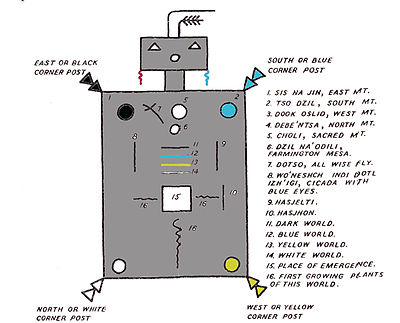 Ni' Hodisxos is the Fourth World, the White World. When the people emerged into the Fourth World, the waters from the Great Flood in the Third World continued to rise, and Big Water Creature pushed her head through the opening. First Man wanted to know why she was following them, and First Angry Coyote showed him her two daughters whom he had stolen. So Turquoise Boy took a basket and put turquoise in it, with pollen from blue flowers and from corn and from Water Iris, and a crystal. First Angry Coyote put the basket between the two horns of Big Water Creature, and put her daughters in the basket. Big Water Creature returned to her world, and the water receded.
Ni' Hodisxos is the Fourth World, the White World. When the people emerged into the Fourth World, the waters from the Great Flood in the Third World continued to rise, and Big Water Creature pushed her head through the opening. First Man wanted to know why she was following them, and First Angry Coyote showed him her two daughters whom he had stolen. So Turquoise Boy took a basket and put turquoise in it, with pollen from blue flowers and from corn and from Water Iris, and a crystal. First Angry Coyote put the basket between the two horns of Big Water Creature, and put her daughters in the basket. Big Water Creature returned to her world, and the water receded.
The people were on an island in the middle of a lake surrounded by high cliffs, and they could not cross to the rest of the land. They called Water Sprinkler, who brought four stones which he had carried from the Third World. He threw the stones at the cliffs and made holes so that the water began to drain away. Smooth Wind blew, and the mud dried up, and the people were able to cross to the land.
First Man and First Woman built the first hogan to live in. First Man cut four poles, one from the Male Reed, one from the Female Reed, and two from the Black Bow. First Woman ground white corn, and they put the powder on the poles and sprinkled cornmeal on the ground inside the hogan, moving from east to west. First Man said, "May my home be sacred and beautiful, and may the days be beautiful and plenty." This was the first hogan-raising ceremony and House Blessing. First Man told the people that they must always bless each new hogan that was built.
First Man and First Woman started to plan how people would live on the earth, and Great Coyote came to help them. They did not ask First Angry Coyote because he was the one who brought strife and unhappiness. They took a perfect buckskin, and placed a large round turquoise and a perfect white shell upon it. First Angry Coyote asked what they were doing, but they didn't tell him, so he went away.
First Man fetched the Black Ye'i (Fire God) to the hogan, then First Man and First Woman called the other three Ye'is and they also came. They told Turquoise Boy and White Shell Girl that they were creating the sun and the moon, and they asked if Turquoise Boy would be the sun, and if White Shell Girl would be the moon. Again, First Angry Coyote came and asked what they were doing, but they didn't tell him, so he went away.
First Man, First Woman, Great Coyote, and the four Holy People planned that there would be twelve months. Every month, the moon would move from dark to light, and the sun would move to a different part of the sky.
They gave White Shell Girl a whistle with twelve holes, made from Female Reed. Each time she came to the end of a cycle she was to blow her whistle and a new month would begin.
The first month is called Back-to-Back, or Parting of the Seasons - it is around the time of October.
The second month is Time of Slender Winds.
The third month is Great Wind, and is the time when people should start telling the sacred stories.
The fourth month is Crusted Snow, corresponding to January, and is a time for many ceremonies and the telling of sacred stories.
The fifth month is Baby Eagle, and after this the sacred stories should not be told to the children.
The sixth month is Sudden Spring Storms, when the fields must be blessed before planting.
The seventh month is Little Leaves.
The eighth month is Tąątsoh; the ninth When Few Seeds Ripen; the tenth Great Seed Ripening, the eleventh Little Ripening, and the twelfth Harvest Time.
First Angry Coyote came and asked what they were doing, but they didn't tell him, so he went away.
Then Black Ye'i, the Fire God, heated the turquoise with his fire until it became red hot, and they asked Turquoise Boy to enter the glowing turquoise. He replied, "If I do that, then I must be paid with the lives of everything that lives on the earth - all the people, the human beings, the animals, the birds, the insects, the fishes, and the people under the water."
White Shell Girl said the same thing.
First Woman, First Man, Great Coyote, and the Holy People all agreed. So Turquoise Boy entered the glowing turquoise, and White Shell Girl entered the white shell, which First Man had heated with his crystal. The people made four circles round the inside of the hogan to complete the ceremony.
So Turquoise Boy became the sun, and White Shell Girl became the moon, and the East Wind carried the sun to his place.
Then First Angry Coyote returned, and wanted to know why they had not included him in the plans, and said that he would spoil their plans - the sun and the moon would not return to their places after twelve months, but would be out of balance. The twelve months of the sun would be thirteen months of the moon. Sometimes the frost would come early, sometimes it would be late; and sometimes the rains would not come.
Late in the first day, when the sun had nearly set, one of the Nádleeh twins stopped breathing. The people were afraid, and left her alone until the next morning. However, when they went with First Angry Coyote next morning, the twin was gone. One man looked down into the Third World, and saw the twin sitting combing her hair. He called a friend who also looked and saw her.
The people asked First Angry Coyote what they should do. He threw a black rock into Black Water Lake, and told them that if the rock floated, the spirit of the dead person would return to the Fourth World and there would be no death, but if the rock sank the spirit would stay in the Third World, and there would be death. The rock sank, and the people realized that the twin was dead. Then First Man remembered what Turquoise Boy had said, and what they had agreed with him. Four days later, both the men who had looked down at the dead twin also died. Then the people knew that it is dangerous to look at the dead.
First Man, First Woman, Great Coyote and the Holy People planned to make the stars and the constellations. They gathered as many pieces of rock-star mica as they could find, and put them on a blanket. First Man drew a plan in the dirt to show the places for the stars. Black Ye'i put the Pole Star (So'tsoh) in place, First Man placed the Big Dipper and the Pleiades. They had placed many stars and constellations when First Angry Coyote came to see what was going on. He placed a couple of stars, but then got impatient and threw all the rest of the rock-star mica into the sky.
First Man, First Woman, Black Ye'i and Water Sprinkler rebuilt the six sacred mountains from the dirt that First Man had brought from the Third World, and they placed them as they had been in the Third World
In the East they made White Shell Mountain (Dawn Mountain Sisnaajiní, Mount Blanca in Colorado) and decorated it with white shells, with white lightning, with white corn, and with the dark clouds that bring male rain (heavy rainstorms). They made Rock Crystal Boy and Rock Crystal Girl to live there for ever.
In the South the made Turquoise Mountain (Blue Bead Mountian, Tsoodził, Mount Taylor in New Mexico) and decorated it with turquoise, with animals, with dark mist, and with the light clouds that bring female rain (light rain showers). They made "Boy Who is Bringing Back Turquoise" and "Girl Who is Bringing Back Many Ears of Corn" to live there for ever.
In the West they made Abalone Shell Mountain (Dook'o'oosłííd, The San Francisco Peaks in Arizona) and decorated it with abalone shell, with animals, with the dark clouds that bring male rain. They made White Corn Boy and Yellow Corn Girl to live there for ever.
In the North they made Big Sheep Mountain (Dibé Nitsaa, Mount Hesperus in Colorado) and decorated it with black beads, with many plants, with many animals, and with the grey mist that brings female rain. They made Pollen Boy and Grasshopper Girl to live there forever.
Near the center they made Banded Rock Mountain (Soft Goods Mountain, Dził Náʼoodiłii). They did not decorate it, but left it bare. They made "Boy Who Produces Goods" and "Girl Who Produces Goods" to live there forever.
East of Center they made Great Spruce Mountain (Precious stones Mountain, Ch'óol'į'í. They decorated it with pollen and with the clouds that bring female rain. They made "Boy Who Produces Jewels" and "Girl Who Produces Jewels" to live there forever.
Then they taught the people about the sacred mountains, and how to sing chants for them.
The time came when the women who had used objects for sex in the Third World gave birth to the monsters that they had conceived.
A woman who had used an antelope horn gave birth to a child with no head. The people held a council and decided that the baby should be abandoned. They left it to die in a gully - but it lived and became Horned Monster.
A woman who had used an eagle's feather gave birth to a headless child with feathered shoulders - it became Monster Eagle.
A woman who had used a stone gave birth to a headless child with hard skin and a pointed neck - it became "Monster Who Kicks People Down Cliff"
A woman who had used a peeled cactus gave birth to twins without heads or limbs, but with two depressions that looked like eyes - they became "Monsters Who Kill with Their Eyes"
Another monster was born when the sun impregnated a woman - that boy was big and angry, and was called Big Giant.
The monsters started to kill and eat travelers, and the people were afraid of them.
First Man wanted to ask the Holy People for help. There was a dark cloud over Great Spruce Mountain, and a fire on top, but for three days First Woman was afraid to let First Man go there. On the fourth day he insisted on going, and sang a chant as he traveled. When he reached the top of the mountain he heard a baby crying. There was a flash of lightning and a great rainbow with bright colors. Suddenly the rain stopped, and he saw a turquoise girl figure on the ground. First Man picked up the turquoise girl figure and took her home.
Two days later First Man and First Woman heard the cry of Talking God, "wu'hu, wu'hu". He had come to tell them that they must bring the turquoise girl back to the mountain in twelve days time. They did so, and found Talking God and House God and Water Sprinkler there with the Wind. Talking God laid a perfect buckskin on the ground, and First Man put the turquoise girl figure on the buckskin. Talking God covered her with another buckskin, and the Holy People sang a sacred song. The Wind entered between the buckskins, and when the upper skin was removed, there was a living baby girl. Her name was Asdząą Nádleehé, Changing Woman. The Holy People told First Man and First Woman to take her home and raise her as their daughter.
After two days, the baby laughed for the first time. First Angry Coyote arrived and said, "I was told that my grandchild laughed for the first time.". First Woman gave him a piece of charcoal and said, "This is the only thing that lasts." He painted his nose with it and was satisfied. That is why one gives a gift when a baby laughs for the first time, and the First Laugh Ceremony is performed.
By the thirteenth day (some say the fourth day), Changing Woman had become a young woman. First Man dressed her in beautiful clothes and jewels of white shell, turquoise, abalone shell, and jet, and she ran her first race, running as far as she could towards the dawn, then returning. She did this for four nights, and during the days she took part in other ceremonies.
Then all the people had a great sing for her, and the Night Chant was sung. This is the Way that the First Race (Kinaalda' ) of every young woman should be celebrated.
Changing Woman wanted a mate. She had a vision of a young man dressed in white, riding a white horse. He told her that her father should build a hogan for her, and she should put a basket of cornmeal in the hogan. She was to wait all night in the hogan. For three nights she saw no-one, but some of the cornmeal was taken from the basket. On the fourth night she felt that someone touched her. (Some versions recount a second impregnation while she was bathing in water.) Then four days later she felt a baby move within her. On the ninth day Changing Woman gave birth to twin boys.
Talking God took the first baby boy and cared for it; Water Sprinkler took the second baby boy and cared for it. After four days the twins had grown into big boys and Talking God and Water Sprinkler started to train them to race. They chased them round the mountain, whipping them with switches of mountain mahogany. The boys practiced, and on the fourth race they won the race. Talking God and Water Sprinkler said, "Well done Shinálí (grandsons). You have grown into what we wanted you to become. Now you can serve well those who nurtured you."
The twins asked Changing Woman who their father was, but she told them that they had no father.
First Man made bows and arrows for the twins, and they went hunting.
The twins went to the south and saw a large black bird, but it flew away when they tried to shoot it. They told Changing Woman about it, and she told them that it was Raven, that it might be a spy for Monster Bird, and that they were not to go there again.
The next day the twins went to the west and saw a large black bird with a red head, but it flew away when they tried to shoot it. They told Changing Woman about it, and she told them that it was Vulture, that it might be a spy for Monster Who Kicks People Down Cliffs, and that they were not to go there again.
The next day the twins went to the north and saw a large black and white bird with a piercing voice, but it flew away when they tried to shoot it. They told Changing Woman about it, and she told them that it was Magpie, that he was a spy for Monster Who Kills With His Eyes. Changing Woman said, "Now the monsters know about you, and they will come to kill you. Stay inside."
The next morning Changing Woman saw the monsters coming from the south and the west and the north. She made four sacred hoops and threw the white one to the east, the blue one to the south, the yellow one to the west, and the black one to the north. A strong wind blew around the hogan. She told the twins, "The wind is too strong for the monsters. We will be safe for one day, but by tomorrow the power will be gone."
The twins decided to go away so that the others would be safe.
Before dawn they ran down the holy path (the rainbow) to the east. At daybreak they came to Banded Rock Mountain and saw smoke rising from the ground. They found that it came from a hole leading to an underground room with a ladder. There was an old woman sitting by a small fire in the room - she was Spider Woman. She invited the boys inside and asked who they were and why they were walking the Holy Trail. The boys explained that they were fleeing from the monsters, and that they did not know who their father was. Spider Woman told them that their father was the Sun, and that the way to him was dangerous, and that he might harm them. She told them of the dangers and the monsters that they would meet, and she gave them a sacred hoop made from the feathers of eagles, and she taught them a song that would protect them.
The twins continued on their journey to the east, and met the dangers which Spider Woman had warned them about. They used the sacred hoop, and sang the song of Spider Woman, and eventually they came to the turquoise house of the Sun.
When the twins entered the house of the Sun they saw a woman and two young men, Black Thunder and Blue Thunder. The two young men wrapped the twins in the four blankets of red dawn, blue daylight, yellow evening, and black darkness, and put them on a shelf.
When the Sun arrived he removed his glowing hot disk from his back and hung it on the wall. Then he asked who the two strangers were that he had seen come to the house. The woman pulled the blankets off the boys. The Sun tested the boys with four deadly trials, but they used the sacred hoop that Spider Woman had given them, and with the help of Wind they survived the tests. Then the Sun said that he would help them, but that the monster Big Giant was also his son, so he himself would have to strike the first blow against Big Giant. He gave arrows and knives to the Twins, and when he started his journey the next day he took the Twins with him.
At noon they came to the hole in the top of the sky, and looked down on the world. They could see the sacred mountains, and the Sun sent lightning down to Turquoise Mountain, where Big Giant lived, and the Twins slid down the lightning.
The Twins managed to kill Big Giant with the help of Wind. From then on, the older brother was called Monster Slayer, and the younger was He Who Cuts Life Out of the Enemy, and he was also called Born of Water.
The next day the Twins met Talking God and Water Sprinkler, who praised them and sang songs to celebrate their victory over Big Giant. These two songs are still sung today whenever a victory is celebrated.
The Twins returned home and saw Changing Woman and First Man and First Woman. They told them about Spider Woman, and about killing Big Giant.
Then Monster Slayer killed Horned Monster with the help of Gopher and Ground Squirrel. Gopher took some of Horned Monster's hair and put it on his own back - that is why gophers have thick hair to this day. Ground Squirrel put some of Horned Monster's blood on his face - that is why ground squirrels have red marks on their faces to this day.
Monster Slayer killed most of the other monsters, but Old Age Woman still remained. Monster Slayer came to kill her, but she told him that if she was no longer there the people would have no children. It was better for people to pass on their wisdom and responsibilities to those who were younger, and then die. So Monster Slayer let her live.
Cold Woman also remained alive. She lived on the top of Big Sheep Mountain with the mountain sheep. Every year she froze the streams and killed the plants. Monster slayer went to kill her, but she told him that if he did, the earth would always be hot, and the springs would cease to flow, and the land would dry up. So Monster Slayer let her live.
The Poverty Creatures also remained alive. They were an old man and an old woman who lived at Roof Butte. Monster Slayer came to kill them, but they told him that they made things wear out so that people would invent new things. So Monster Slayer let them live.
Hunger Man also remained alive. Monster Slayer came to kill him, but he told him that if people did not feel hungry they would never know the pleasures of cooking and eating and they would not plant seeds, harvest crops, or be skilled hunters. So Monster Slayer let him live.
Monster Slayer went home and sang a song of thanks.
Now the enemy slayer arrives.
From the house of the jagged blades he arrives.
From where the sharp knives hang he arrives.
And the treasures he has won are yours, oh you gods.
Then Changing Woman and the Twins heard a voice from the east chanting a reply
With the Slayer of Monsters I come.
From the house of the dark stone blades I come.
From where the dark stone knives hang I come.
Giver of the sacred hoops I come.
I come, I come! The dreaded one.
Changing Woman recognized the voice of Sun, the Twins' father. She told the Twins to dress, and she left the hogan.
When the Sun entered the hogan he greeted the Twins, and asked Monster Slayer if he had killed all the Monsters. Monster Slayer said that he had killed all those who should die. The Sun told Monster Slayer to give him back the weapons which he had given him, and that he wished to speak to Changing Woman on top of Giant Spruce Mountain in four days.
After four days Changing Woman went to the top of Giant Spruce Mountain and sat on a rock near where she had first become pregnant. The Sun came to her and asked her to go with him to the West.
She said that she would not go unless he made her a beautiful house in the West like his house in the East. It was to be built floating on the water, so that the Earth-Surface people could not bother her with their quarrels. It was to have white shell, blue shell, turquoise, abalone, soapstone, agate, redstone, and jet. There were to be buffalo, deer, mountain sheep, jackrabbits, prairie dogs, and muskrats.
The Sun asked why she wanted all those things, and she replied,
"You are male and I am female. You are of the sky and I am of the earth. You are constant in your brightness, but I must change with the seasons. Remember that I willingly let you enter me and I gave birth to your sons, enduring pain to bring them into the world. As different as we are, we are of one spirit. As dissimilar as we are, you and I, we are of equal worth. As different as we are, there must be solidarity between us. There can be no harmony in the universe unless there is harmony between us. If there is to be harmony, my request must matter to you. There is to be no more coming from me to you than there is from you to me."
The Sun promised to give her all she wished.
When Changing Woman was ready to go to her new home the Mirage People and the Ground Mist People went with her. She said farewell to First Man, First Woman and her two sons. Then she and the Holy People went through the mountains and in Ch'íńlį' valley they celebrated her betrothal to the Sun. Then she came to the end of the land, and went to her floating house beyond the shore.
In the house of Changing Woman there was a shelf running from East to West on the South side of the house, and a shelf running from West to East on the North side of the house.
On the shelf on the South side there were four water jars which contained the Male Rains. The first was a Black Water Jar which contained the Black Cloud; the second was a Blue Water Jar which contained the Blue Cloud; the third was a Yellow Water Jar which contained the Yellow Cloud; and the fourth was a White Water Jar which contained the White Cloud .
On the shelf on the North side there were another four water jars which contained the Female Rains. The first was a Black Water Jar which contained the Black Vapor; the second was a Blue Water Jar which contained the Blue Vapor; the third was a Yellow Water Jar which contained the Yellow Vapor; the fourth was a White Water Jar which contained the White vapor.
There were also other jars which contained the seeds of plants and flowers.
When Changing Woman walks in the four directions from her house she is changed.
When she leaves the house she is an old woman with a white bead walking stick.
When she walks to the East, she returns as a middle-aged woman without the walking stick.
When she walks to the South she returns as a young woman.
When she walks to the West she returns as a maiden.
When she walks to the North she returns as a young girl.
Changing Woman and the Sun are often in harmony, but sometimes they argue. When that happens the Sun does not go to her house at the end of his journey, and the sky is stormy and the whole world suffers.
The Sun said it was time for the first four Holy People to leave the surface of the Fourth World. These were the Holy People who had come from the First World : First Man, First Woman, Great Coyote, and First Angry Coyote. They traveled East beyond the house of the Sun, and took their powers with them.
First Woman said, "When I wish to do so, I will send back death from disease, and the sign will be the howl of the coyote."
The four Holy People who had come from the Third World were Talking God, Water Sprinkler, House God, and Black God. They returned to their homes and took their powers with them.
Talking God said, "If anyone sees us it will be a sign that an enemy is coming into the country. If he hears us call, that same person will be killed by an enemy before the day is over."
![]()
A Ye'i (pronounced "yay") is a spiritual being similar to the kachina of the Hopi. They are known as the "terrible, but benevolent, ones"
Male Ye'is are usually depicted with round heads, and may have horns, feathers, caps, or masks. They have straight bodies and wear kilts.
Female Ye'is have square heads.
Ye'is may have tassels on their arms or clothes, and may carry a variety of objects such as wands, staves, or corn.
Talking Ye'i (Xasce lti'i) leads the others Ye'is in bringing healing to people. He is regarded as "Grandfather of the Ye'is" and is invoked during the Night Way. Talking Ye'i is in charge of the dawn, the east, and the hunt. He advises folk heroes. He is associated with Mount Humphreys. His cry is "whu whu", and his partner is Calling Ye'i
Calling Ye'i (Xasce oyan) is in charge of the evening, the west, and agriculture. His cry is "hahowa" and his partner is Talking Ye'i
Water Sprinkler or Grey Ye'l (To'neinili or ibáhi) is the Water Carrier for the Ye'i and is in charge of rain. He extinguishes the fires from lightning which Black Ye'i causes. His cry is "yuh" and his partner is Black Ye'i
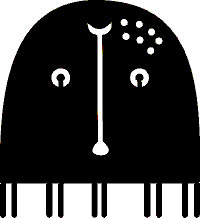
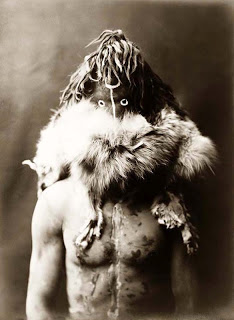 Black Ye'i (Haskéshjini or Xasce shchini) is in charge of fire. He created fire and the fire drill and the constellations. He wears the seven stars of the Pleiades (the Dilyéhé) on his forehead. The Pleiades are important to the Navajo because their appearance in the eastern sky heralds the approach of winter frosts. Black Ye'is partner is Water Sprinkler
Black Ye'i (Haskéshjini or Xasce shchini) is in charge of fire. He created fire and the fire drill and the constellations. He wears the seven stars of the Pleiades (the Dilyéhé) on his forehead. The Pleiades are important to the Navajo because their appearance in the eastern sky heralds the approach of winter frosts. Black Ye'is partner is Water Sprinkler
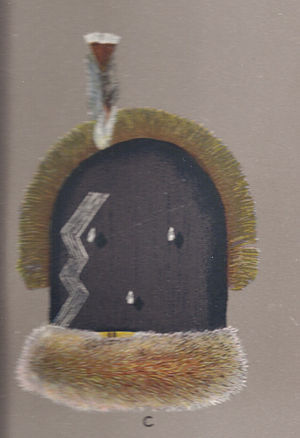
 Monster Slayer (Nayenezgani or Naye nezyani) is the elder of the Hero Twins or War Twins. His symbol is a bow, representing the weapon he used to slay various monsters. He may also be represented by a red head feather, or by zig-zag lightning.
Monster Slayer (Nayenezgani or Naye nezyani) is the elder of the Hero Twins or War Twins. His symbol is a bow, representing the weapon he used to slay various monsters. He may also be represented by a red head feather, or by zig-zag lightning.
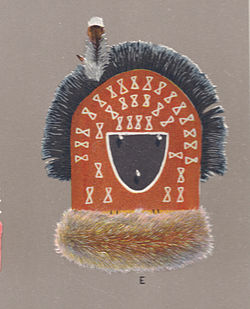 Born-for-Water or Child-of-Water (To'baadsistini or To'baachis'chini) is the younger of the Hero Twins. When Monster Slayer shot the monsters with his bow, Child-of-Water scalped them - this may be the origin of the hour-glass shaped figure which represents Born-of-Water in sand paintings and pictographs.
Born-for-Water or Child-of-Water (To'baadsistini or To'baachis'chini) is the younger of the Hero Twins. When Monster Slayer shot the monsters with his bow, Child-of-Water scalped them - this may be the origin of the hour-glass shaped figure which represents Born-of-Water in sand paintings and pictographs.
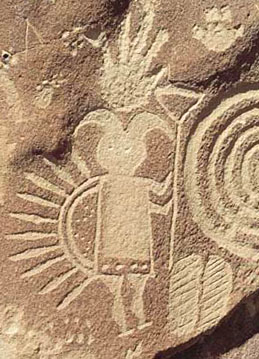 Humpbacked Ye'i (Ghaan'ask'idii or Ya'askidi) is a fertility spirit similar to the Anasazi Kokopelli. His humped back represents a sack full of seeds, and is often decorated with eagle feathers. He wears sheep horns, and carries a staff or a planting stick.
Humpbacked Ye'i (Ghaan'ask'idii or Ya'askidi) is a fertility spirit similar to the Anasazi Kokopelli. His humped back represents a sack full of seeds, and is often decorated with eagle feathers. He wears sheep horns, and carries a staff or a planting stick.
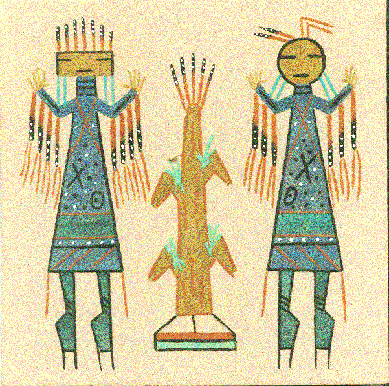 Changing Woman (Asdzą'ą' Nádleehé) represents the earth and the cycle of seasons. She is the consort of the Sun God and is the mother of the Hero Twins.
Changing Woman (Asdzą'ą' Nádleehé) represents the earth and the cycle of seasons. She is the consort of the Sun God and is the mother of the Hero Twins.
![]()
Hózhó expresses the balance and harmony of the natural order - it is often translated as "beauty" The Navajo believe the world to be an orderly place filled with interconnected objects all existing in a state of balance and harmony. The concept of Hózhó is rather like that of "Tao" in Chinese religion - the way the universe fits together.
![]()
ji or Ways, Sings, or Chants are ceremonies which are performed for healing, blessing, or any other religious need of a Navajo. Nearly all Ways also involve the making of a Sand Painting as part of the ritual.
The Blessing Way, Hózhó jí was the first Way given to the Navajo by Changing Woman, and it remains the most important of the Ways. It is used as a general blessing, to restore Hózhó, to bring good luck and health, to repair mistakes made in other religious ceremonies, and when making prayer sticks.
A rough translation is :
In Hózhó I walk.
With Hózhó before me, I walk.
With Hózhó behind me, I walk.
With Hózhó above me, I walk.
With Hózhó below me, I walk.
With Hózhó all around me, I walk.
With Hózhó within me, I walk.
It is finished, with Hózhó restored.
It is finished, with Hózhó restored.
It is finished, with Hózhó restored.
It is finished, with Hózhó restored.
The Enemy Way, 'Anaa' jí, originated with Monster Slayer, who was haunted by the spirits of the monsters that he had killed. It is used to drive out any chindi (evil spirits, ghosts) that settle in someone - this can be due to contact with the dead, or from having killed someone, or having been subject to violence or disturbance of the balance of nature.
The Enemy Way is used to protect Navajo from the dangers of contact with whites - for those who work in non-Navajo businesses, and for children sent to boarding school.
The Enemy Way is the only Way that is not associated with a sand painting.
 The Night Way, Ye'i Bi'Chai, takes nine days to complete, and is a very serious healing Way which must be performed correctly by both the patient and the healers involved. Mistakes could result in blindness, deafness, or crippling.
The Night Way, Ye'i Bi'Chai, takes nine days to complete, and is a very serious healing Way which must be performed correctly by both the patient and the healers involved. Mistakes could result in blindness, deafness, or crippling.
The first four days of the Night Way are spent in cleansing rituals, creating a sand painting, and invoking the Ye'is. The cleansing rituals use a sweat lodge and herbal purgative drinks. During the next four nights the Ye'is arrive and dance and chant around the hogan, and on the last day the cure takes place.
There are various food taboos during and after the Way, and on one night both the patient and the Singer must remain awake until dawn - when the strength of the rising sun will increase the power of the sand painting which is part of the Way. The Night Way gets its name from the Dance of the Masked Gods, which takes place at night and is one of the main features of the Way.
The Night Way is only sung in winter.
The Shooting Way is used for injuries caused by arrows, lightning, and snakes, and also for illnesses of unknown origin.
The Mountain Way is a healing Way which involves hiring paid performers for fire handling and exhibitions of magic acts which are intended to call magical powers. One feature of the performance might be a Fire Dance, where several dancers covered in white clay whirl torches around themselves and each other.
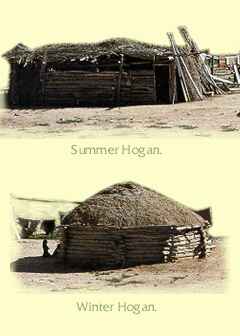 The House Blessing - A hogan must be blessed according to the directions for the first hogan, otherwise it will "feel lonely" and attract spirits to itself. A house blessing is performed by the head of the household that is going to live in the hogan. The ceremony starts with a ritual cleaning of the hogan and the kindling of the fire. Then the inside of the hogan is marked as the dwelling of that particular family - East, South, West, and North are marked with corn meal (sometimes with corn pollen or charcoal). This is followed by songs and prayers specifically for that hogan and its family - the prayers express wishes for happiness, long life, peace, and protection from misfortune.
The House Blessing - A hogan must be blessed according to the directions for the first hogan, otherwise it will "feel lonely" and attract spirits to itself. A house blessing is performed by the head of the household that is going to live in the hogan. The ceremony starts with a ritual cleaning of the hogan and the kindling of the fire. Then the inside of the hogan is marked as the dwelling of that particular family - East, South, West, and North are marked with corn meal (sometimes with corn pollen or charcoal). This is followed by songs and prayers specifically for that hogan and its family - the prayers express wishes for happiness, long life, peace, and protection from misfortune.
This home, my home, shall be surrounded with Hózhó.
This fire shall be for the good of the family.
And the children that may be born in this hogan will all be in good health.
Any plans we make in this hogan will be for the good of the family.
May this be a good place for us to live again, may it be happy in this home;
may our lives be long and happy in this home.
May I live in this home happily and peacefully and with respect.
May I have a happy life in this hogan.
Myself, my wife, my children, my relatives, whomever may come into this hogan, may they relax peacefully and rest up.
May all of us have no sickness, no misfortunes.
May my house be in harmony;
From my head, may it be happy;
To my feet, may it be happy;
Where I lie, may it be happy;
All above me, may it be happy;
All around me, may it be happy;
May my fire be well made and happy;
May the sun, my mother's ancestor, be happy for this gift;
May it be happy as I walk around my house;
May this road of light, my mother's ancestor, be happy.
Charlotte Frisbee, Ritual Drama in the Navajo House Blessing Ceremony, in Southwestern Indian Ritual Drama pp. 161-198 (1980)
The conclusion of the House Blessing Ceremony is the preparation and the sharing of the communal meal.
The Squaw Dance is part of a ceremony which was originally for those returning from a raid, a war, or contact with foreigners (exposure to death and dangerous spirits). It is now used for those who feel the need for healing from bad influences - sickness, drugs, gambling, drinking, etc.
The Way requires four days of chants, sand paintings, and other rituals, which take place at several different locations, and called for as many people as possible to participate and sing. This increased the power of the Way. The expenses of the Way are considerable, so all the extended family is expected to help financially, and guests bring food and money. A special brush hogan has to be built for the Singer and his assistants, and large amounts of food are prepared for the family and guests.
The Way itself is religious, intended for healing and counteracting the problems which someone is encountering. However, the origins of the Squaw Dance section of the Way derive from the introduction of young women ready for marriage when warriors returned. It is social rather than religious. The young women dress in their finest clothes, and wear turquoise and silver to show their wealth. They select partners for a courtship dance from among the young men, and no man is allowed to refuse them unless he can show that he is related by clan. If a man refuses, the girl's female relatives drag him to the center and make him pay a fine.
The Squaw Dances take place every night that the Way is being held, along with other communal songs and swaying shuffling dances. The whole event is a time of family and communal socializing and building of relationships.
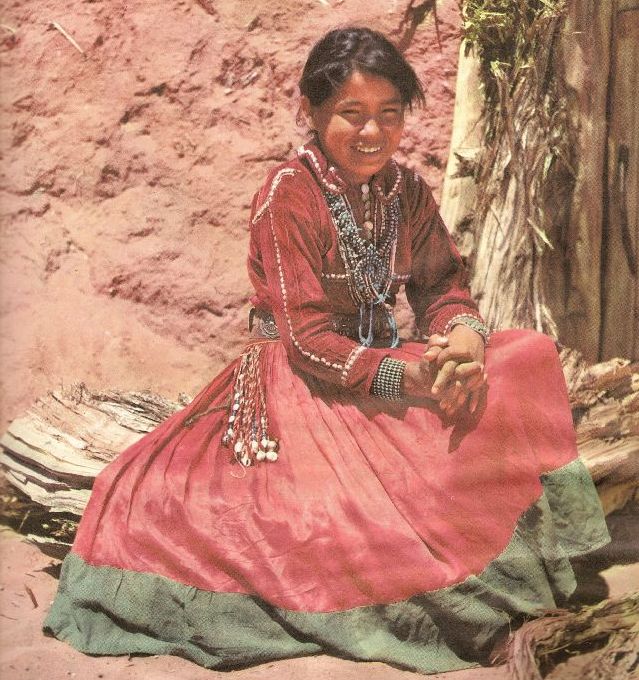
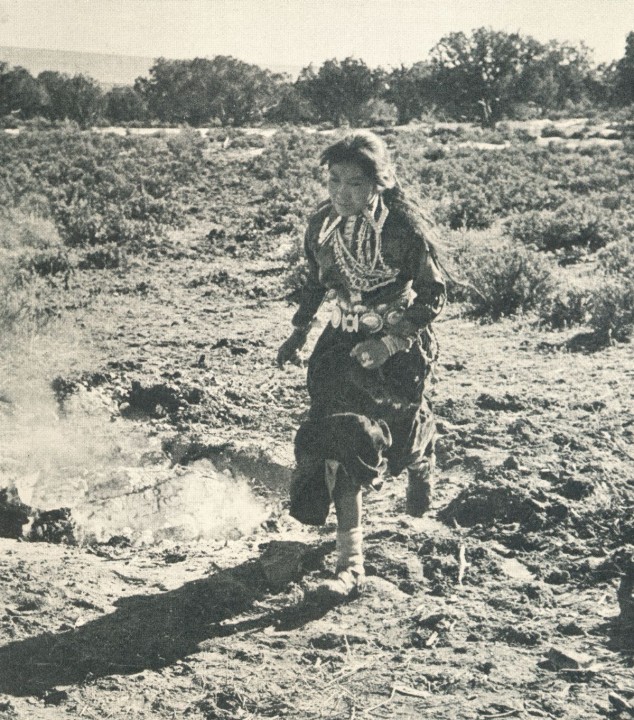 When a Navajo girl reaches puberty she and her family celebrate a kinaalda ceremony, recalling the kinaalda of Changing Woman, and the girl is thought to take on the identity of Changing Woman during the Way. The girl has a sponsor who is an older woman who teaches her about her duties as a Navajo woman and acts as a role model. The ceremony takes several days, during which the girl is dressed in fine traditional clothing. As part of the ceremony, she grinds corn and uses it to bake a cake.
When a Navajo girl reaches puberty she and her family celebrate a kinaalda ceremony, recalling the kinaalda of Changing Woman, and the girl is thought to take on the identity of Changing Woman during the Way. The girl has a sponsor who is an older woman who teaches her about her duties as a Navajo woman and acts as a role model. The ceremony takes several days, during which the girl is dressed in fine traditional clothing. As part of the ceremony, she grinds corn and uses it to bake a cake.
On the first day she dresses in her finest clothes, and runs to the east for about a quarter of a mile, and then runs back again. Then she grinds corn and prepares a pot of wheat.
On the second day she runs again, and grinds more corn, and spreads the wheat out to dry in the sun.
On the third day she runs again, grinds more corn, and digs a pit, lines it with corn husks, builds a fire, makes cornmeal mush, puts it in the pit and covers it with more corn husks to cook. Then she gathers soapweed (yucca) root and white clay.
In the evening, the ha'atli sings some of the hogán songs. Then others present may sing.
At sunrise on the fourth day, her mother washes her hair with the soapweed suds and dries it with cornmeal. Then she runs again, and this time the children of the village run with her, to show that she will be a good mother. While she is running the ha'atli sings some of the racing songs. When she returns the corn-cake is brought in and everyone eats some. Then she may return to the hogan.
There are many other Ways - some for healing, some to be used when making things such as arrows or moccasins, some for dealing with monsters or witches, and some to be used when hunting animals or trapping eagles.
The Ways are taught by a Singer to a student; they are not written down or recorded because of their sacred nature. A great cause for concern is that Singers are growing old and dying before the next generation has learnt all the Ways, so some of the Ways are being lost.
![]()
Although many Navajos have personal songs, or know some of the sacred songs which they use for themselves, only a recognized singer (sometimes referred to as a medicine man), a ha'atli, can preside over a Way.
A singer is trained by becoming an apprentice to an established singer, and learning the Ways and the chants from them.
The rituals, skills, songs and accessories needed for a Way are very complex and require years to memorize under the tutelage of a practicing singer. The apprentice pays with personal service or with livestock, food, or money. If a Way were learned any other way, without payment, the knowledge would be of no value because it would, in
effect, be stolen and thus not the true property of the singer.
Only a recognized Singer can perform a Way for curing another person, but Singers are not regarded as priests. They live normal lives, farming and herding as do others. They are paid or given gifts for performing a Way.
![]()
 Sand Paintings ('iikáá) are used in many of the Ways, as a place for the Ye'is to come - and then leave when the painting is destroyed when it has been used. They are similar to Puebloan Kiva Paintings. The Ye'is taught the paintings to the Navajo, and the designs have remained almost unchanged for centuries. The figures are stretched and angular, to show that they are not human beings. The dimensions, colors and alignment must be precisely correct, otherwise the sand painting will not have the curative properties required, and may in fact be harmful. The top of the painting is to the east, with an opening to allow the entrance of the healing power of Dawn. The other three sides have guardians to prevent evil from entering on those sides - the guardians may be pictures of a rainbow, a bear, a fly, or one of several other beings. If the rainbow also represents a Ye'i it is painted as a bow of red (sunshine) and blue (water), bent so that the head is at one end and the feet at the other, with the opening towards the east. The head is square, because the Rainbow Ye'i is female. Sand paintings for instruction or for sale to tourists have some intentional mistake in them (omission of a figure, a change of color, etc.) so that they will not have any magical powers.
Sand Paintings ('iikáá) are used in many of the Ways, as a place for the Ye'is to come - and then leave when the painting is destroyed when it has been used. They are similar to Puebloan Kiva Paintings. The Ye'is taught the paintings to the Navajo, and the designs have remained almost unchanged for centuries. The figures are stretched and angular, to show that they are not human beings. The dimensions, colors and alignment must be precisely correct, otherwise the sand painting will not have the curative properties required, and may in fact be harmful. The top of the painting is to the east, with an opening to allow the entrance of the healing power of Dawn. The other three sides have guardians to prevent evil from entering on those sides - the guardians may be pictures of a rainbow, a bear, a fly, or one of several other beings. If the rainbow also represents a Ye'i it is painted as a bow of red (sunshine) and blue (water), bent so that the head is at one end and the feet at the other, with the opening towards the east. The head is square, because the Rainbow Ye'i is female. Sand paintings for instruction or for sale to tourists have some intentional mistake in them (omission of a figure, a change of color, etc.) so that they will not have any magical powers.
The power of a sand painting lies in its symmetry and order. Making a sand painting requires a great concentration of the body's energy to maintain symmetry, order and balance.
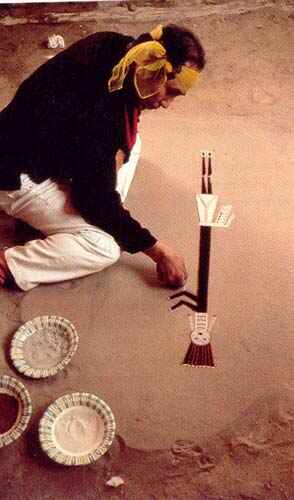 The "sand" used for sand paintings is actually powdered stone and charcoal :
The "sand" used for sand paintings is actually powdered stone and charcoal :
Black, used to represent North and rain (which comes from the north) is made from charcoal with some red sandstone.
White is made from white sandstone.
Blue is made by mixing black and white - although it is really grey, it appears as blue amongst the other colors.
Yellow is made from yellow sandstone.
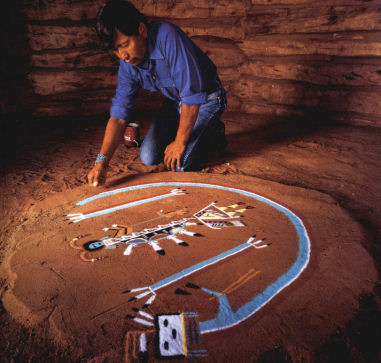 A sand painting is usually made on a smooth flat sand base, by trickling the colored sands through the thumb and forefinger. It is drawn from the center outwards, from east, then south, then west, then north. A figure is painted from feet to head - the figure is painted first, then the decorations such as feathers and clothing are added on top of the body painting.
A sand painting is usually made on a smooth flat sand base, by trickling the colored sands through the thumb and forefinger. It is drawn from the center outwards, from east, then south, then west, then north. A figure is painted from feet to head - the figure is painted first, then the decorations such as feathers and clothing are added on top of the body painting.
If a mistake is made it is healed by performing a Blessing Way, then the mistake is covered by clean sand and the painting continued.
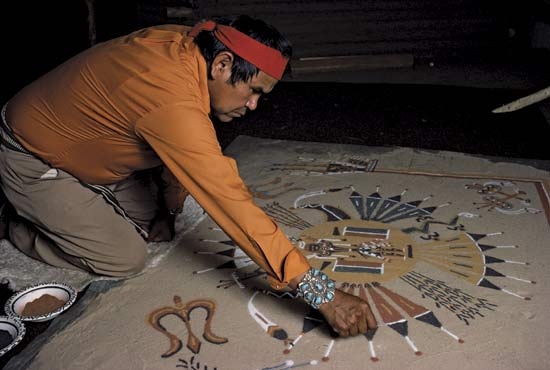 When the sand painting is finished, it is just an empty vessel waiting for the Ye'is. The Singer sprinkles sacred pollen and other articles from his medicine bundle around the sand painting. The Way continues as the patient is prepared, then sand from the sand painting is put on his body, thus bringing him into contact with the power of the Ye'is.
When the sand painting is finished, it is just an empty vessel waiting for the Ye'is. The Singer sprinkles sacred pollen and other articles from his medicine bundle around the sand painting. The Way continues as the patient is prepared, then sand from the sand painting is put on his body, thus bringing him into contact with the power of the Ye'is.
At the conclusion of the Way, the sand still retains some magical power, so it is swept up and disposed of according to specific rituals to prevent harm coming to the Singer or to the patient.
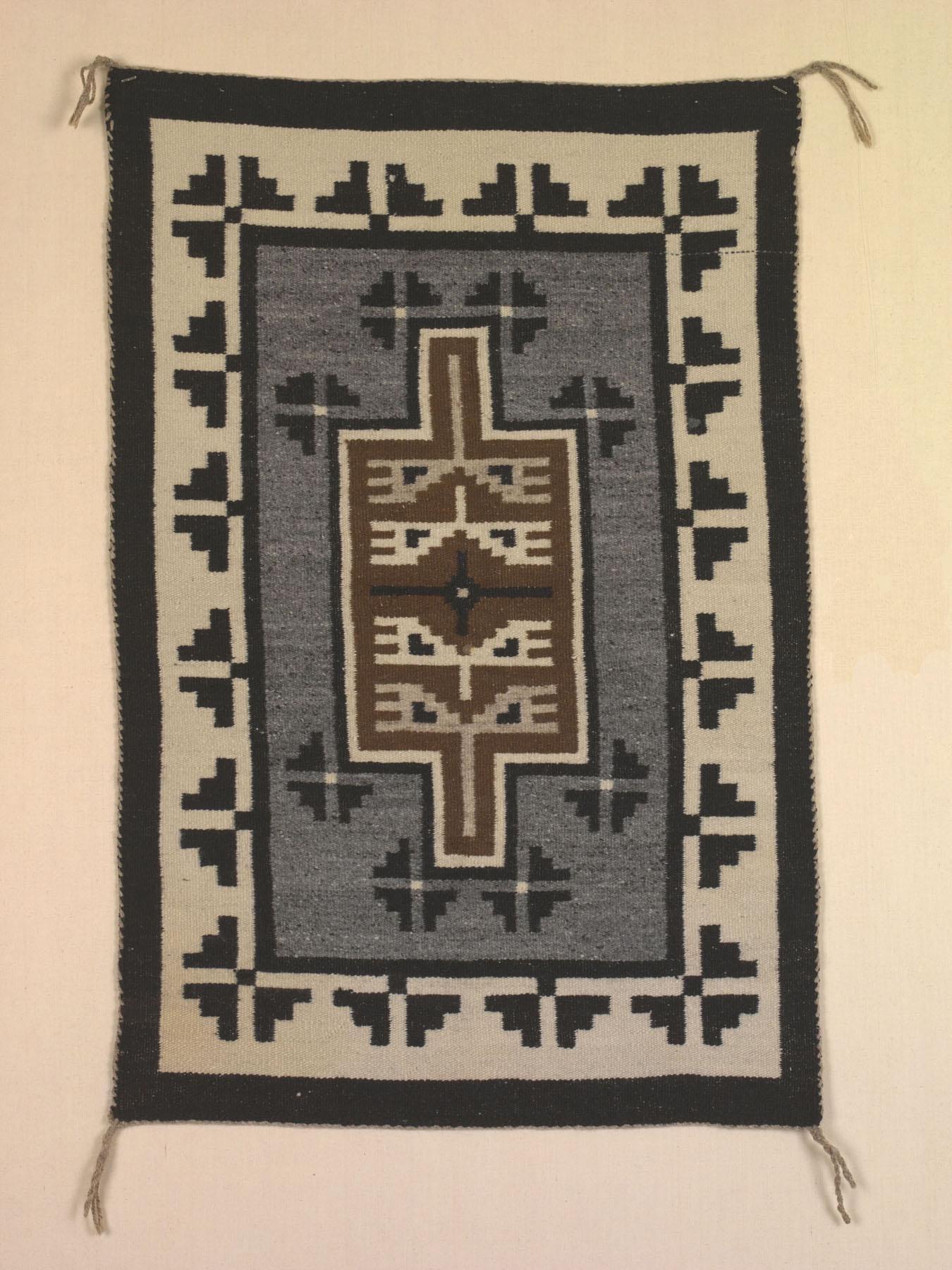
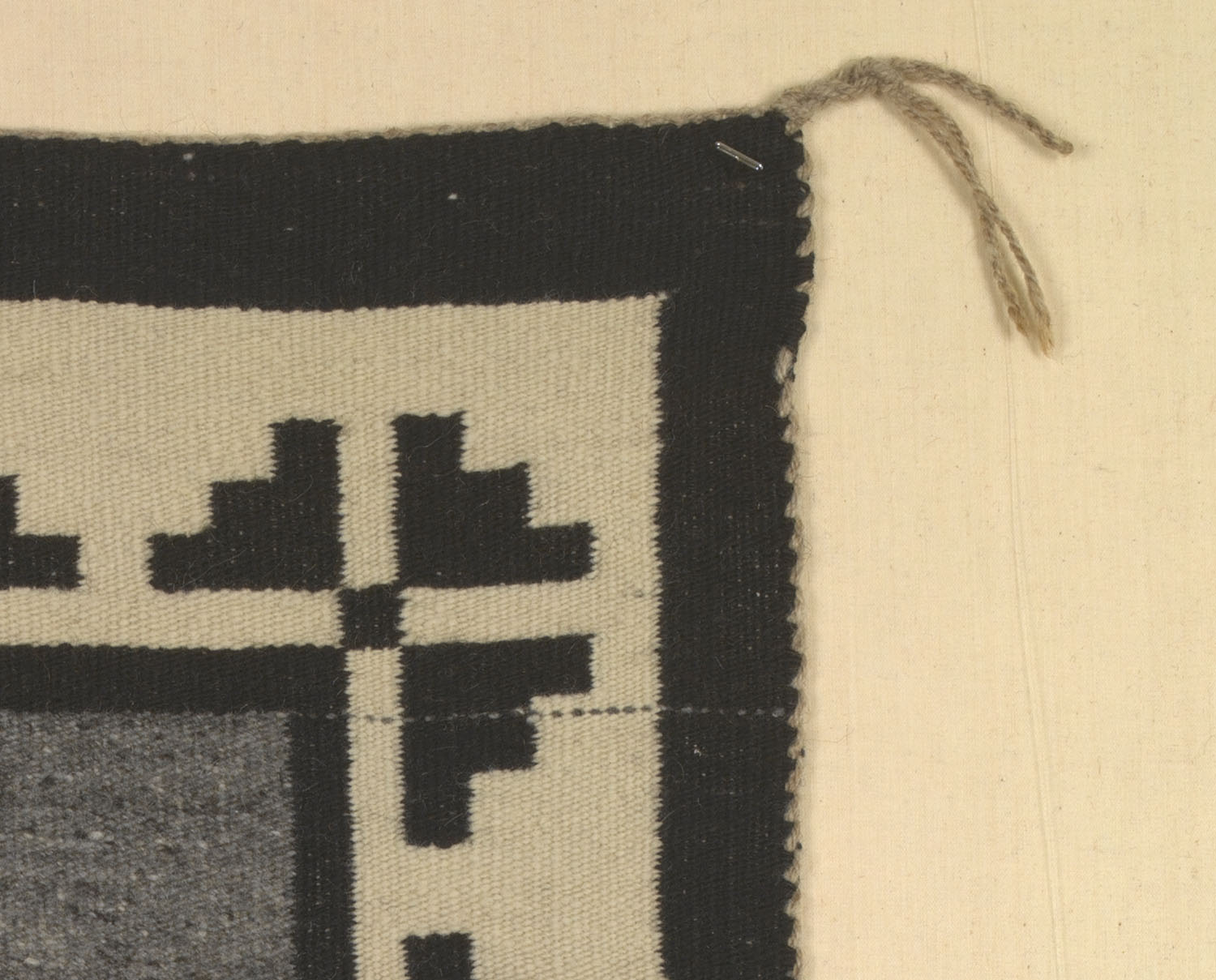 Although Navajo textiles (rugs) do not portray sacred subjects, the process of weaving involves the weaver's spirit, and the weaver has an intimate connection with the finished textile. This is one of the reasons given for the spiritline or spirit pathway, ch’ihónít’i (way out) or ‘atiin (road), which is a dark thread woven into the top right-hand corner of the rug. It usually leads from inside the border of the inner design to the outer border, and was made to concentrate and release the weaver's intentions and thoughts out of the woven object.
Although Navajo textiles (rugs) do not portray sacred subjects, the process of weaving involves the weaver's spirit, and the weaver has an intimate connection with the finished textile. This is one of the reasons given for the spiritline or spirit pathway, ch’ihónít’i (way out) or ‘atiin (road), which is a dark thread woven into the top right-hand corner of the rug. It usually leads from inside the border of the inner design to the outer border, and was made to concentrate and release the weaver's intentions and thoughts out of the woven object.
While weaving, a weaver can put thoughts, prayers, blessings, and personal qualities into the material. This may be done intentionally, if the textile is intended for a family member or friend. Weavers try to think good thoughts when weaving, so that they will go into the textile and influence others in the future.
However, many Navajo rugs are made for sale to non-Navajos, and in this case the weaver needs to release herself from the textile. This may be done by songs and Ways, and also by use of the spiritline.
Other reasons given for using a spiritline are that it honors the powerful and sacred tradition of weaving, or to release any negative effects that might be trapped in the weaving, or to release the weaver's mind from the borders of weaving and keep her sane.
Seen as an intentional "flaw" in the weaving, one of the reasons given is that it is to show that the weaver is not perfect, or to leave room for future improvement in the weaving art, to leave an opening for the next generation of weavers.
![]()
The medicine bundle (jish) is used in various rituals. It must be made from the skin of a deer which has died without a wound - obtaining such a skin involves catching a deer with a rope and suffocating it in a ritual manner. The medicine bundle takes several years to assemble, and its contents are collected from places within Dinétah - including all four sacred mountains.
A Singer's medicine bundle contains a sacred fire drill, for starting the fire to be used in a sweat lodge such as is used in the Night Way.
![]()
The Sweat Bath is an important way of religious purification and cleansing - particularly in a land where water is scarce.
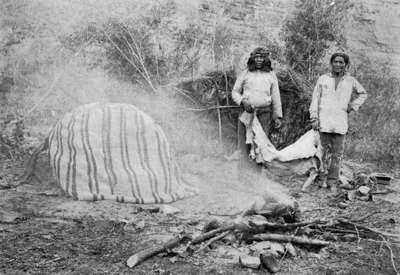 A Navajo home usually has a Sweat Lodge nearby. Typically it is partially underground, eight to ten feet wide, and roofed with branches and dirt. It has a small entrance that is closed by blankets. Rocks are heated in a fire, and then put in one corner of the Sweat Lodge. Special precautions have to be taken when preparing for a Sweat Bath. Normally only the men join in a Sweat Bath. When the heated rocks are in place and the entrance sealed with the blankets the men start to sing. They sing sets of four chants, asking for good health, healthy animals, good crops, rain, and wealth. When the Sweat is over the blankets are pulled away, and the men come out and roll in the dust to dry themselves.
A Navajo home usually has a Sweat Lodge nearby. Typically it is partially underground, eight to ten feet wide, and roofed with branches and dirt. It has a small entrance that is closed by blankets. Rocks are heated in a fire, and then put in one corner of the Sweat Lodge. Special precautions have to be taken when preparing for a Sweat Bath. Normally only the men join in a Sweat Bath. When the heated rocks are in place and the entrance sealed with the blankets the men start to sing. They sing sets of four chants, asking for good health, healthy animals, good crops, rain, and wealth. When the Sweat is over the blankets are pulled away, and the men come out and roll in the dust to dry themselves.
A Sweat Bath serves not only for removing dirt, but also for religious cleansing and as part of healing Ways. In such ceremonies, healing plants are also used during the Sweat.
![]()
There are four sacred colors :
White (igai) represents the Dawn and the East. It is linked to Mt. Blanca in New Mexico. Males are believed to have been created from white corn, and are shown in white in sand paintings.
Black (izhin) represents Night, the sky, and the North. It is linked to Mt. Hesperus in Colorado. Black is a sinister color, but it also protects with invisibility. Monster Slayer has a black mask, and the Place of Emergence is shown as black.
Blue (doot'izh) represents Mid-day and the South. It is linked to Mt. Taylor in New Mexico
Yellow (itso) represents Evening and the West. It can also symbolize fertility and reproduction. It is linked to the San Francisco Peaks in Arizona. Females are believed to have been created from yellow corn, and are shown in yellow in sand paintings
Though not a sacred color, red may be used to denote blood and flesh, and hence plentiful meat. Red also is a color of war, danger, and sorcery, and of protection from them. Red ochre is used in many Ways, especially for exorcisms.
![]()
The Navajo people are divided into clans, which were created by the Holy Ones. The four original clans were made by Changing Woman from some of her skin; they are Towering House, Bitterwater, One-who-walks-around, and Mud Clan (some claim Big Water Clan instead). Today there are about 130 clans, including clans for other nations who have been adopted into the Navajo clan system during their travels. The Mescalero, Chiricahua, and Jicarilla Apaches were imprisoned at Bosque Redondo with the Navajo in the 1860s, and joined them in the walk home - they form three of the newer clans. The Paiutes were adopted as a clan, but were left behind because of religious differences. On a journey to the south the Navajo adopted the Mexicans as a clan. Other peoples who are associated with clans are the Mojave, Pima, Zuni, Comanche, Ute, and Pueblo peoples. Recently a new clan has been created for African Americans - Naahiłii or Nahiłii - from Na (those who have come across), hil (dark, calmness, have overcome and persevered, and whom we've come to like), and ii (oneness).
So far, there is no clan for Anglos - they are referred to as Bilaga'ana.
A Navajo baby is born "into" the clan of its mother, "for" the clan of its father. The clan name is inherited from the mother.
Navajo must marry outside their clans, to avoid incest and keep the blood strong. When Navajo meet one another for the first time they introduce themselves by identifying what clans they are from. They give the clans of mother and father and grandparents. If they are of the same clan they regard one another as sister and brother, and know that they should not become romantically attracted, because that might lead to incest, which is taboo.
Families are matrilineal, and tend to live closely together. In the past, survival depended upon a family keeping close to one another and supporting one another.
![]()
When a person dies, the good parts of his spirit move on, but the bad parts stay as a chindi to haunt people unless proper precautions are taken. Navajo never speak the name of someone who has died - doing so would call the chindi to haunt them.
Someone who is about to die often moves out of the hogan, because if someone dies in a hogan, it must be abandoned. The body may be left inside with its belongings. Burial is done quickly and without much ceremony; a person's favorite valuable possessions may be buried with them.
When someone is ill they may be moved from the hogan in which they lived and taken to a temporary hogan in which to die. After death, the helpers clean the hogan using juniper branches to erase all footprints which may have been made by the relatives of the deceased in the hogan. This is to hide the direction that they went, so that the chindi will not be able to follow them.
The next day, the east doorway is sealed, and a hole is cut in the north wall of the hogan and the body carried out through the hole. Then the hogan and all its contents were usually burned.
When a death occurs in a permanent house today, the house can be cleansed and blessed and is then considered safe to live in.
Copyright © 1999 Shirley J. Rollinson, all Rights Reserved